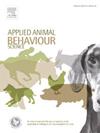Deck height did not affect behavioural measures of ‘natural movements’ and ‘adequate ventilation’ during 8 h and 23 h transport of weaner pigs
IF 2
2区 农林科学
Q1 AGRICULTURE, DAIRY & ANIMAL SCIENCE
引用次数: 0
Abstract
Annually, more than 30 million weaner pigs cross borders between EU member states mainly transported for further production. The current EU regulation states that the internal deck height of the transport vehicles must on no account hinder natural movements and provide adequate ventilation but without including specific norms. The aim of the present study was to examine impact of deck height (60 vs 80 cm and 70 vs 90 cm) on behaviour reflecting natural movements and adequate ventilation during 16 short (8 h) and 16 long (23 h) journeys of 20–25 kg pigs, mimicking commercial conditions. A secondary aim was to describe the behaviour progressed from departure to arrival including the driver break during short journeys. To address the aim, the first task was to select appropriate behavioural measures that could robustly be annotated with the limited vertical space. As a consequence, head butting against the ceiling and drinking behaviour were omitted in pilot observations. The final behaviours were body posture including huddling and huddling location analysed using 15 min interval instantaneous scan sampling. The frequency of aggression and a pig standing on another pig was recorded using continuous sampling during selected 20 min recording sessions (in total 160 and 120 min for short and long journeys, respectively). During short journeys, this included recording sessions placed immediately before, during and after the mandatory break of the livestock driver. Mixed effects models were used to analyse effects of deck height and the following co-variates: hour since departure, microclimatic conditions and vehicle speed.
No effect of deck height was found on any of the selected behavioural measures. When examining behaviour of the pigs before, during and after the break, no differences in lying behaviour were found, but for one of the vehicle elements, the trailer, an increase in aggressive behaviour was observed during the break. Overall, the results showed a complex pattern of relations affecting the behaviour of the pigs, such as the microclimatic conditions and driving speed interacting with hour since departure. These findings varied to some extent depending on vehicle element (lorry or trailer) and journey duration (8 h or 23 h, with the associated different stocking densities). Taken together, the results showed that increasing the deck height did not lead to detectable changes in the behaviour of the weaner pigs, but that many other factors influenced the behaviour of weaners during transport and may thus also influence their welfare.
在8 h和23 h的断奶猪运输过程中,甲板高度不影响“自然运动”和“充分通风”的行为测量
每年有超过3000万头断奶猪在欧盟成员国之间跨境运输,主要用于进一步生产。目前的欧盟法规规定,运输车辆的内部甲板高度在任何情况下都不得妨碍自然运动,并提供足够的通风,但没有包括具体的规范。本研究的目的是研究甲板高度(60 vs 80 cm和70 vs 90 cm)对20-25 kg猪在16次短途(8 h)和16次长途(23 h)期间反映自然运动和适当通风的行为的影响,模拟商业条件。第二个目的是描述从出发到到达的过程,包括短途旅行中的司机休息时间。为了实现这一目标,第一个任务是选择适当的行为措施,这些措施可以在有限的垂直空间中进行稳健的注释。因此,在飞行员观察中忽略了头撞天花板和饮酒行为。最终行为是身体姿势,包括蜷缩和蜷缩的位置,使用15 min间隔瞬时扫描采样分析。在选择的20次 分钟记录期间(短途和长途分别为160分钟和120 分钟),使用连续采样记录攻击频率和一头猪站在另一头猪上的频率。在短途旅行中,这包括在牲畜司机强制休息之前、期间和之后立即进行录音。混合效应模型用于分析甲板高度和以下协变量的影响:离船时间、小气候条件和车速。没有发现甲板高度对任何选定的行为测量的影响。在检查猪在休息前,休息期间和休息后的行为时,没有发现说谎行为的差异,但对于一种交通工具,拖车,在休息期间观察到攻击行为的增加。总体而言,结果显示了影响猪行为的复杂关系模式,例如小气候条件和驾驶速度与出发后小时的相互作用。这些结果在一定程度上取决于车辆成分(卡车或拖车)和旅行时间(8 h或23 h,与不同的放养密度相关)。综上所述,结果表明,增加甲板高度并没有导致断奶猪的行为发生可检测到的变化,但许多其他因素影响了断奶猪在运输过程中的行为,因此也可能影响它们的福利。
本文章由计算机程序翻译,如有差异,请以英文原文为准。
求助全文
约1分钟内获得全文
求助全文
来源期刊

Applied Animal Behaviour Science
农林科学-行为科学
CiteScore
4.40
自引率
21.70%
发文量
191
审稿时长
18.1 weeks
期刊介绍:
This journal publishes relevant information on the behaviour of domesticated and utilized animals.
Topics covered include:
-Behaviour of farm, zoo and laboratory animals in relation to animal management and welfare
-Behaviour of companion animals in relation to behavioural problems, for example, in relation to the training of dogs for different purposes, in relation to behavioural problems
-Studies of the behaviour of wild animals when these studies are relevant from an applied perspective, for example in relation to wildlife management, pest management or nature conservation
-Methodological studies within relevant fields
The principal subjects are farm, companion and laboratory animals, including, of course, poultry. The journal also deals with the following animal subjects:
-Those involved in any farming system, e.g. deer, rabbits and fur-bearing animals
-Those in ANY form of confinement, e.g. zoos, safari parks and other forms of display
-Feral animals, and any animal species which impinge on farming operations, e.g. as causes of loss or damage
-Species used for hunting, recreation etc. may also be considered as acceptable subjects in some instances
-Laboratory animals, if the material relates to their behavioural requirements
 求助内容:
求助内容: 应助结果提醒方式:
应助结果提醒方式:


